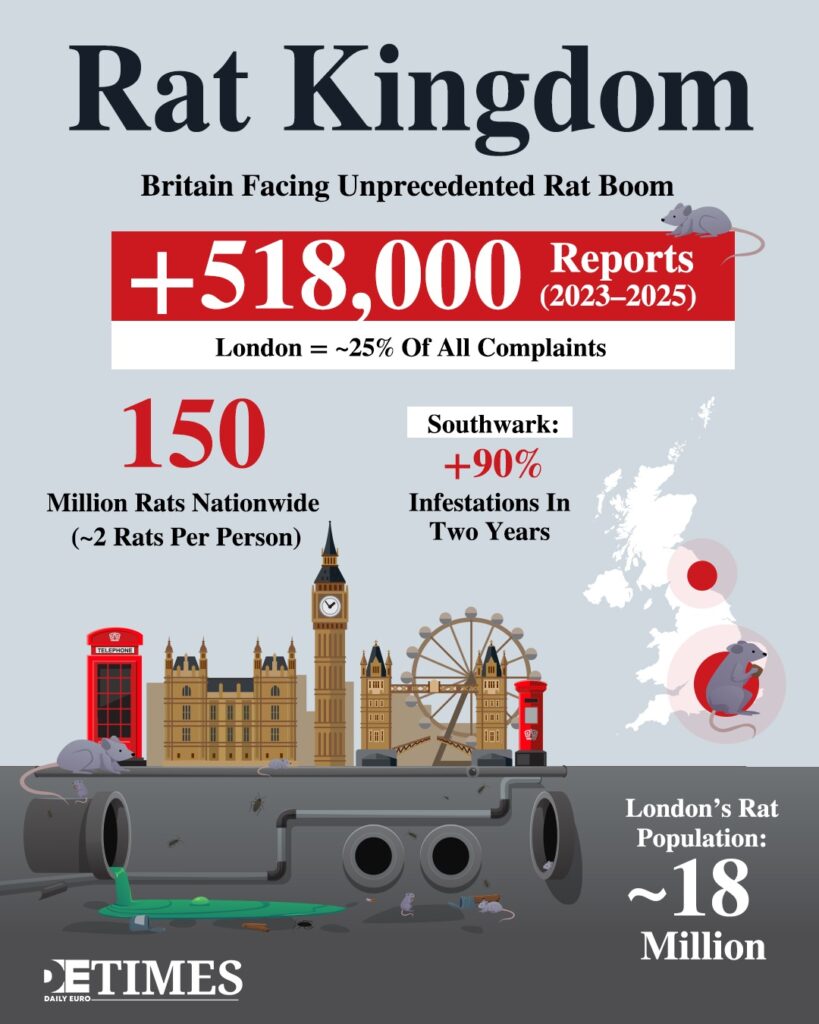Freedom of Information data shows that between 2023 and 2025, councils across Britain received over 518 thousand reports about rats, with London alone accounting for almost a quarter of these complaints.
But these numbers only scratch the surface.
Rats now outnumber people two to one nationwide, turning cities into spaces where humans live alongside an estimated 150 million rodents.
Economic Causes of the Rat Explosion
The rise in rat numbers comes from predictable issues. Southwark saw a 90% jump in infestations, and Sunderland faced similar increases.
These trends reflect wider problems of urban neglect. COVID lockdowns pushed rats from closed restaurants into residential neighbourhoods as food availability shifted during the pandemic.
City development creates perfect habitats for rats through poorly managed waste and easy access to food scraps.
Construction sites offer hiding places, while irregular rubbish collection provides plentiful meals.
A Global Problem Reflecting Local Failures
Britain’s rat surge is part of a worldwide pattern of poor urban management.
Data from 16 major cities reveals that 69% are seeing rat populations rise, including places like Washington DC, New York, and Amsterdam.
Climate change speeds up how quickly rats breed, as warmer temperatures extend their breeding seasons.
Cities, as heat islands, create ideal conditions for rats to multiply, while dense populations supply an endless food source.
This link between rising temperatures and rat growth exposes how environmental shifts make existing urban planning failures worse.
Britain’s population is expected to reach 72.5 million by 2032, with more people living in cities – meaning more waste and more rats unless the system changes.
History Repeats Itself
In medieval Europe, the Black Death wiped out a third of the population due to diseases spread by rats. While modern sanitation stops plague outbreaks, rats still carry many harmful germs.
London has about 18 million rats – roughly two for every person living there. This is more rats than ever seen in urban history, posing new health risks.
This historical comparison reminds us that economic inequality fuels health threats.
Medieval cities lacked sewer systems and waste collection; today’s British cities have the infrastructure but often fail to keep it in good shape.

Rodent Numbers as a Measure of City Health
The number of rats in a city is a clear sign of how well local authorities manage public services.
Cities with fewer rats usually invest in good waste disposal, building upkeep, and public health.
Out of 16 cities studied, only three managed to reduce rat populations by investing in consistent urban planning and public infrastructure.
These examples show that controlling rats needs long-term, coordinated efforts – not just spot treatments with poison.
British cities have a lot to learn from these success stories. Effective rat control means combining better waste collection, stricter building management, and cleaner public areas.
Moving From Killing Rats to Preventing Them
Using poison alone doesn’t work because it only addresses the problem temporarily. When rats die off, new ones quickly take their place.
To really control rats, cities must fix the root causes: irregular trash pickup, rundown buildings, and easy food access.
While these solutions require upfront investment, they save money in the long run by cutting health problems and property damage.
Evidently, Britain can keep spending resources on short-term extermination or put money into lasting improvements that stop rats at their source.
Rats reveal the true health of cities more accurately than economic reports or political promises.
Their growing numbers are a warning sign of deep-running failures that need serious, structural solutions – not just quick fixes.
Keep up with Daily Euro Times for more updates!
Read also:
AECD Forum Go Ahead Despite Vision 2030 Hiccups
Leading Cultural Destinations in Qatar
Casablanca’s Urban Revolution: What Europe’s Cities Are Missing






